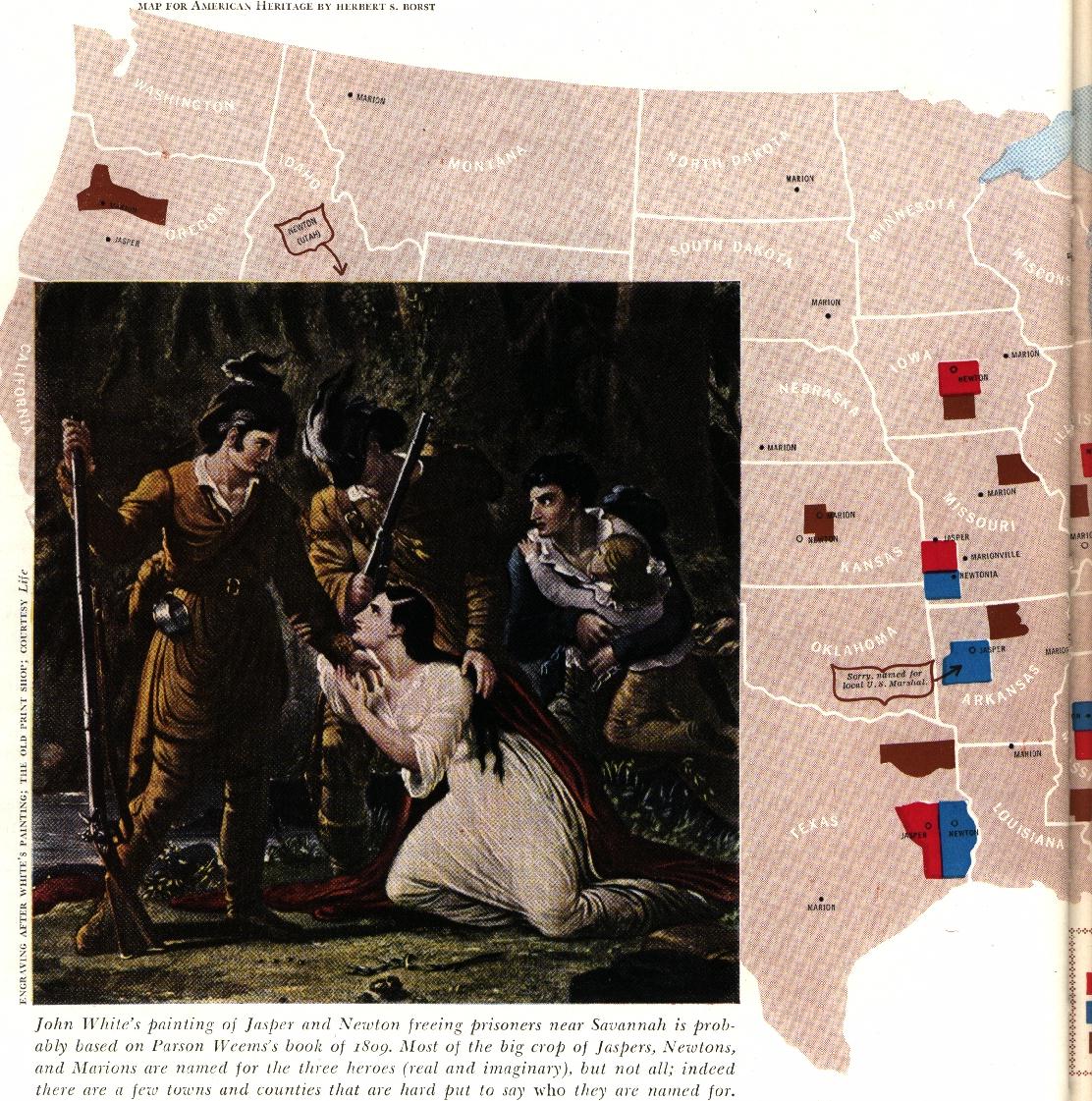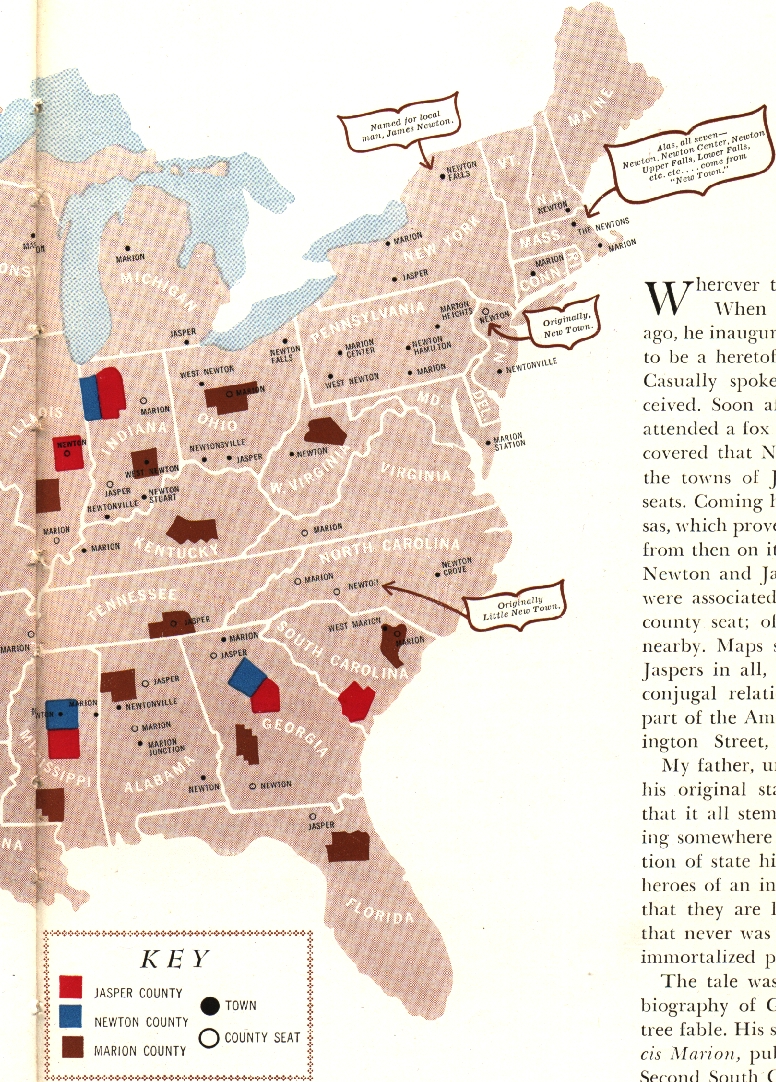MYTH on
the MAP


Scores of towns and counties all over the nation honor
some heroics largely invented by Parson Weems
By LOU ANN EVERETT
Wherever there's a Newton, there's a Jasper."
When my father said that to me three years ago,
he inaugurated a search that reveals what I believe to be a heretofore
unrelated bit of American history. Casually spoken, his remark had
been casually received. Soon afterward, however, my husband and I
attended a fox hunt in Jasper County, Texas, and discovered that Newton
County was next to it and that the towns of Jasper and Newton were their
county seats. Coming home, we drove through Jasper, Arkansas, which
proved to be the seat of Newton County, and from then on it seemed that
no matter where we went Newton and Jasper were on the way. Sometimes
they were associated as counties, sometimes as county and county seat;
often a town or county of Marion was nearby. Maps showed more than
sixty Newtons and Jaspers in all, half of them juxtaposed in an almost
conjugal relationship. They were about as much a part of the American
scene as Lincoln avenue, Washington Street, and Courthouse Square.
But why?
My father, unfortunately, had offered no reason
for his original statement beyond the vague suggestion that it all stemmed,
somehow, from a painting hanging somewhere in South Carolina. My
own investigation of state histories reveals that they commemorate heroes
of an incident that may never have happened, that they are linked together
because of a dialogue that never was spoken, and that one of the men thus
immortalized probably was a thief and a villain.
The tale was told by Mason Locke Weems, whose biography
of George Washington created the cherry tree fable. His second book,
The
Life of General Francis Marion, published in 1809, dealt largely with
the Second South Carolina Infantry Regiment of Revolutionary War fame,
and there it was that "Parson" Weems related the exploits of two of Marion's
sergeants, Newton and Jasper. One day in the spring of 1779, the
Parson related, the pair emerged from their hiding place beside a spring
near Savannah and dramatically rescued a number of American prisoners,
among them a woman and child, from a party of ten British captors.
In the process, the two Americans disposed of one enemy sergeant, one corporal,
and two privates, capturing the remaining six, while they themselves were
not even scratched. According to Weems, Jasper and Newton were at
no loss for rich, fruity dialogue as they embarked upon their heroic deed.
Let the good Parson tell it:
The brave are always tender-hearted. It was so
with Jasper and Newton, two of the most undaunted spirits that ever lived
. . .
"Newton," said [Jasper], "my days
have been but few; but I believe their course is nearly done."
"Why so, Jasper?"
"Why, I feel," said he, "that I must
rescue these poor prisoners; or die with them; otherwise that woman and
her child will haunt me to my grave."
"Well, that's exactly what I feel
too," replied Newton--"and here is my hand and heart to stand by you, my
brave friend, to the last drop. Thank God, a man can die but once;
and there is not so much in this life that a man need be afraid to leave
it, especially when he is in the way of his duty."
The two friends then embraced with
great cordiality, while each read in the other's countenance that immortal
fire which beams from the eyes of the brave, when resolved to die or conquer
in some glorious cause.
Conquer they did. Nor was the liberated lady
ungrateful. Weem's narrative continues:
. . . She exclaimed, "Where? Where are those blessed
angels that God sent to save my husband?"
Directed by our looks to Jasper and
Newton, where they stood like two youthful Samsons, in the full flowing
of their locks, she ran and fell on her knees before them, and seizing
their hands, kissed and pressed them to her bosom, crying out vehemently--"dear
angels! dear angels! God bless you! God Almightly bless
you forever!"
The story was accepted as gospel by the literalistic
people of the day, and ever since then the gallant Newton and the undaunted
Jasper have been standing staunchly side by side--even thought the one
man who undoubtedly knew the true facts said it simply wasn't so.
That was Brigadier General Peter Horry, whose own name was on the book's
title page along with that of Weems. Horry had written and given
to Weems a sketch history of Marion's brigade, and the redoubtable Parson
had promised to get it published. Horry had admonished him "not to
alter the sense or meaning of my work, least when it came out I might not
know it; and, perverted, it might convey a very different meaning from
the truth."
When the book appeared, Horry was horrified.
He wrote to Weems, ". . . You have carved and mutilated it . . . Most certainly
'tis not MY history, but YOUR romance." Horry's indignant disavowels
went unnoticed by a public that would not be denied its heroes. In
the years after the book was published--for the most part between 1820
and 1850--new towns and counties springing up all over America adopted
the names of one or the other of Weems's bold sergeants.
In William Jasper, at least, the public was not
entirely deluded. He was a bona fide hero, whom General William Moultrie
called a "brave, active, stout, strong, enterprising man, and a very great
partizan," and "a perfect Proteus in his ability to alter his appearance."
He held a roving commission as a scout and part-time spy, but mostly he
is remembered for rescuing his regimental banner during the bombardment
of Fort Sullivan (later called Moultrie) in 1776, after which new colors
were presented to the regiment by a Mrs. Susanna Elliot, Jasper died defending
them during the siege of Savannah.
Weems seems to have used his imagination freely
in creating that "blessed angel" of the fiery eye and brave demeanor, Sergeant
Newton. He said that Newton was Jasper's "particular friend . . .
son of an old Baptist preacher and a young fellow for strength and courage,
just about a good match for Jasper himself." But Horry, uselessly
of course, wrote: "Jasper was an Honest Man; but Newton was a Thief &
a Villain." Since neither Weems nor Horry gave Newton a first name,
it is hard to prove just who he was. Four Newtons served with the
regiment, but two were fifers and another a private. The only Sergeant
Newton--his name was John--was discharged on April 17, 1778, a year before
the alleged exploit at Savannah.
The inscription on the Jasper Monument in Savannah
doesn't mention Sergeant Newton, but his name does appear on a marker that
now stands a few miles west of Savannah at Jasper Spring, the site of the
alleged incident. All later writings seem to take Weems's book as
the ultimate source of the incident, but perhaps the basis for the entire
story was this excerpt from an article in the Virginia Gazette of
May 15, 1779: "The brave Sergeant with another seargeant, crossed Savannah
River, took, and brought to Major General Lincoln's headquarters, two Captains,
named Scott and Young, of the British troops in Georgia."
It is unlikely that we will ever know the real truth
of the matter, and it doesn't seem quite fair to the memory of General
Horry. Weems was applauded for his writing, Jasper and Newton were
honored throughout the land, but Horry had just one little county in South
Carolina named after him. And after all, it was his notes, mightily
improved upon by the Parson, that started the whole thing.
Mrs. Lou Ann Everett, a former reporter for the Tulsa
World,
now lives in Sand Springs, Oklahoma, where she and her husband publish
a weekly newspaper, the Times, and a national fox-hunting monthly
called The Hunter's Horn.
[This article appeared in the December, 1958, American Heritage.
It has been reprinted on the Web, without permission, in reply to a question
raised on the Roadmaps-L mailing list. It's appearance here is temporary.
Unreadable due to the page split in the above image are Marion, Wisconsin,
and Newton, Mississippi. Parson Weems was behind a whole slew of
myths about early American history which will apparently haunt us
forever. --16 July, 2000]

